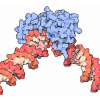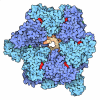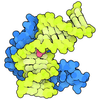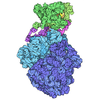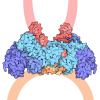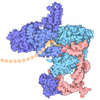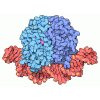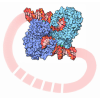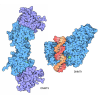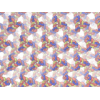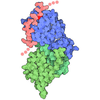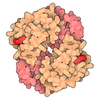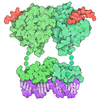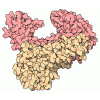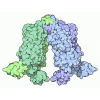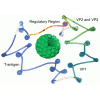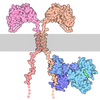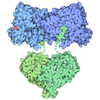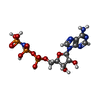+ Open data
Open data
- Basic information
Basic information
| Entry | Database: PDB / ID: 9kbh | ||||||
|---|---|---|---|---|---|---|---|
| Title | The structure of B19V NS1_2-570/ssDNA/AMPPNP | ||||||
 Components Components |
| ||||||
 Keywords Keywords | DNA BINDING PROTEIN/DNA / Human parvovirus B19 / NS1 / DNA BINDING PROTEIN-DNA COMPLEX | ||||||
| Function / homology |  Function and homology information Function and homology informationviral genome replication / endonuclease activity / DNA helicase / DNA replication / host cell nucleus / DNA binding / ATP binding / metal ion binding Similarity search - Function | ||||||
| Biological species |  Human parvovirus B19 Human parvovirus B19 | ||||||
| Method | ELECTRON MICROSCOPY / single particle reconstruction / cryo EM / Resolution: 3.3 Å | ||||||
 Authors Authors | Gan, J. / Zhang, Y. | ||||||
| Funding support |  China, 1items China, 1items
| ||||||
 Citation Citation |  Journal: Nucleic Acids Res / Year: 2025 Journal: Nucleic Acids Res / Year: 2025Title: Structural and functional studies of the main replication protein NS1 of human parvovirus B19. Authors: Yixi Zhang / Boming Fan / Yanqing Gao / Jie Yang / Weizhen Zhang / Shichen Su / Linxi Li / Huili Li / Zhaorong Luo / Guangli Tang / Chenxi Wang / Xueting Zhang / Hehua Liu / Jianhua Gan /  Abstract: Parvovirus B19 (B19V) is a ubiquitous virus that can infect the majority of human population and cause erythema infectiosum, acute arthropathy, and many other diseases. The main replication protein ...Parvovirus B19 (B19V) is a ubiquitous virus that can infect the majority of human population and cause erythema infectiosum, acute arthropathy, and many other diseases. The main replication protein NS1 plays a critical role in cell cycle arrest, transactivation of viral and host genes, and replication and package of B19V genome. Both DNA nicking and unwinding activities are required for the in vivo function of NS1, but the underlying basis is poorly understood. Here, we report extensive structural and biochemical studies of NS1, showing that NS1 can unwind various types of DNA substrates. The cryo-electron microscopy (cryo-EM) structures reveal the detailed mechanisms for ATP binding and hydrolysis, and DNA binding and unwinding by NS1. In addition to the SF3 HD domain, the C-terminal region is also required for double-stranded DNA (dsDNA) nicking by NS1. Unexpectedly, instead of enhancing, the dsDNA nicking activity of NS1 is negatively regulated by its DNA unwinding ability, suggesting that they likely function in different stages. This study advances our understanding of the structure and function of NS1 and other parvoviral replication proteins, such as the Rep proteins of adeno-associated virus. | ||||||
| History |
|
- Structure visualization
Structure visualization
| Structure viewer | Molecule:  Molmil Molmil Jmol/JSmol Jmol/JSmol |
|---|
- Downloads & links
Downloads & links
- Download
Download
| PDBx/mmCIF format |  9kbh.cif.gz 9kbh.cif.gz | 328.8 KB | Display |  PDBx/mmCIF format PDBx/mmCIF format |
|---|---|---|---|---|
| PDB format |  pdb9kbh.ent.gz pdb9kbh.ent.gz | 257.2 KB | Display |  PDB format PDB format |
| PDBx/mmJSON format |  9kbh.json.gz 9kbh.json.gz | Tree view |  PDBx/mmJSON format PDBx/mmJSON format | |
| Others |  Other downloads Other downloads |
-Validation report
| Summary document |  9kbh_validation.pdf.gz 9kbh_validation.pdf.gz | 2 MB | Display |  wwPDB validaton report wwPDB validaton report |
|---|---|---|---|---|
| Full document |  9kbh_full_validation.pdf.gz 9kbh_full_validation.pdf.gz | 2 MB | Display | |
| Data in XML |  9kbh_validation.xml.gz 9kbh_validation.xml.gz | 64.9 KB | Display | |
| Data in CIF |  9kbh_validation.cif.gz 9kbh_validation.cif.gz | 95 KB | Display | |
| Arichive directory |  https://data.pdbj.org/pub/pdb/validation_reports/kb/9kbh https://data.pdbj.org/pub/pdb/validation_reports/kb/9kbh ftp://data.pdbj.org/pub/pdb/validation_reports/kb/9kbh ftp://data.pdbj.org/pub/pdb/validation_reports/kb/9kbh | HTTPS FTP |
-Related structure data
| Related structure data |  62225MC  9kbgC  9kbiC  9kbjC M: map data used to model this data C: citing same article ( |
|---|---|
| Similar structure data | Similarity search - Function & homology  F&H Search F&H Search |
- Links
Links
- Assembly
Assembly
| Deposited unit | 
|
|---|---|
| 1 |
|
- Components
Components
| #1: Protein | Mass: 62681.031 Da / Num. of mol.: 6 Source method: isolated from a genetically manipulated source Source: (gene. exp.)  Human parvovirus B19 / Production host: Human parvovirus B19 / Production host:  #2: DNA chain | | Mass: 20606.125 Da / Num. of mol.: 1 / Source method: obtained synthetically / Source: (synth.)  Human parvovirus B19 Human parvovirus B19#3: Chemical | ChemComp-ANP / #4: Chemical | ChemComp-MG / Has ligand of interest | Y | Has protein modification | N | |
|---|
-Experimental details
-Experiment
| Experiment | Method: ELECTRON MICROSCOPY |
|---|---|
| EM experiment | Aggregation state: PARTICLE / 3D reconstruction method: single particle reconstruction |
- Sample preparation
Sample preparation
| Component | Name: B19V NS1_2-570 with ssDNA and AMPPNP / Type: COMPLEX / Entity ID: #1-#2 / Source: MULTIPLE SOURCES |
|---|---|
| Molecular weight | Value: 0.38 MDa / Experimental value: YES |
| Source (natural) | Organism:  Human parvovirus B19 Human parvovirus B19 |
| Source (recombinant) | Organism:  |
| Buffer solution | pH: 8 |
| Specimen | Embedding applied: NO / Shadowing applied: NO / Staining applied: NO / Vitrification applied: YES |
| Specimen support | Grid material: GOLD / Grid mesh size: 300 divisions/in. / Grid type: Quantifoil R1.2/1.3 |
| Vitrification | Cryogen name: ETHANE / Humidity: 100 % / Chamber temperature: 295 K |
- Electron microscopy imaging
Electron microscopy imaging
| Experimental equipment |  Model: Titan Krios / Image courtesy: FEI Company |
|---|---|
| Microscopy | Model: TFS KRIOS |
| Electron gun | Electron source:  FIELD EMISSION GUN / Accelerating voltage: 300 kV / Illumination mode: FLOOD BEAM FIELD EMISSION GUN / Accelerating voltage: 300 kV / Illumination mode: FLOOD BEAM |
| Electron lens | Mode: BRIGHT FIELD / Nominal defocus max: 2000 nm / Nominal defocus min: 1200 nm |
| Image recording | Electron dose: 50 e/Å2 / Film or detector model: TFS FALCON 4i (4k x 4k) |
- Processing
Processing
| EM software | Name: PHENIX / Version: 1.19.1_4122: / Category: model refinement | ||||||||||||||||||||||||
|---|---|---|---|---|---|---|---|---|---|---|---|---|---|---|---|---|---|---|---|---|---|---|---|---|---|
| CTF correction | Type: PHASE FLIPPING AND AMPLITUDE CORRECTION | ||||||||||||||||||||||||
| 3D reconstruction | Resolution: 3.3 Å / Resolution method: FSC 0.143 CUT-OFF / Num. of particles: 25268 / Symmetry type: POINT | ||||||||||||||||||||||||
| Refine LS restraints |
|
 Movie
Movie Controller
Controller






 PDBj
PDBj